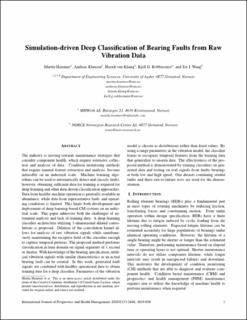| dc.contributor.author | Hemmer, Martin | |
| dc.contributor.author | Klausen, Andreas | |
| dc.contributor.author | Huynh, Khang | |
| dc.contributor.author | Robbersmyr, Kjell Gunnar | |
| dc.contributor.author | Waag, Tor Inge | |
| dc.date.accessioned | 2020-03-24T09:44:37Z | |
| dc.date.available | 2020-03-24T09:44:37Z | |
| dc.date.created | 2020-01-23T14:50:33Z | |
| dc.date.issued | 2019 | |
| dc.identifier.citation | International Journal of Prognostics and Health Management. 2019, 10 . | |
| dc.identifier.issn | 2153-2648 | |
| dc.identifier.uri | https://hdl.handle.net/11250/2648288 | |
| dc.description.abstract | The industry is moving towards maintenance strategies that consider component health, which require extensive collection and analysis of data. Condition monitoring methods that require manual feature extraction and analysis, become infeasible on an industrial scale. Machine learning algorithms can be used to automatically detect and classify faults, however, obtaining sufficient data for training is required for deep learning and other data-driven classification approaches. Data from healthy machine operation is generally available in abundance, while data from representative fault- and operating conditions is limited. This limits both development and deployment of deep learning-based CM systems on an industrial scale. This paper addresses both the challenges of automated analysis and lack of training data. A deep learning classifier architecture utilizing 1-dimensional dilated convolutions is proposed. Dilation of the convolution kernel allows for analysis of raw vibration signals while simultaneously maintaining the receptive field of the classifier enough to capture temporal patterns. The proposed method performs classification in time domain on signal segments of 1 second or shorter. With knowledge of the bearing specification, artificial vibration signals with similar characteristics as an actual bearing fault can be created. In this work, generated fault signals are combined with healthy operational data to obtain training data for a deep classifier. Parameters of the vibration model is chosen as distributions rather than fixed values. By using a range parameters in the vibration model, the classifier learns to recognize temporal features from the training data that generalize to unseen data. The effectiveness of the proposed method is demonstrated by training classifiers on generated data and testing on real signals from faulty bearings at both low and high speed. One dataset containing seeded faults and three run-to-failure tests are used for the demonstration. | |
| dc.language.iso | eng | |
| dc.rights | Navngivelse 3.0 Unported (CC BY 3.0) | |
| dc.rights.uri | https://creativecommons.org/licenses/by/3.0/ | |
| dc.title | Simulation-driven Deep Classification of Bearing Faults from Raw Vibration Data | |
| dc.type | Peer reviewed | |
| dc.type | Journal article | |
| dc.description.version | publishedVersion | |
| cristin.ispublished | true | |
| cristin.fulltext | original | |
| cristin.qualitycode | 1 | |
| dc.identifier.cristin | 1780978 | |
| dc.source.journal | International Journal of Prognostics and Health Management | |
| dc.source.volume | 10 | |
| dc.source.pagenumber | 12 | |

